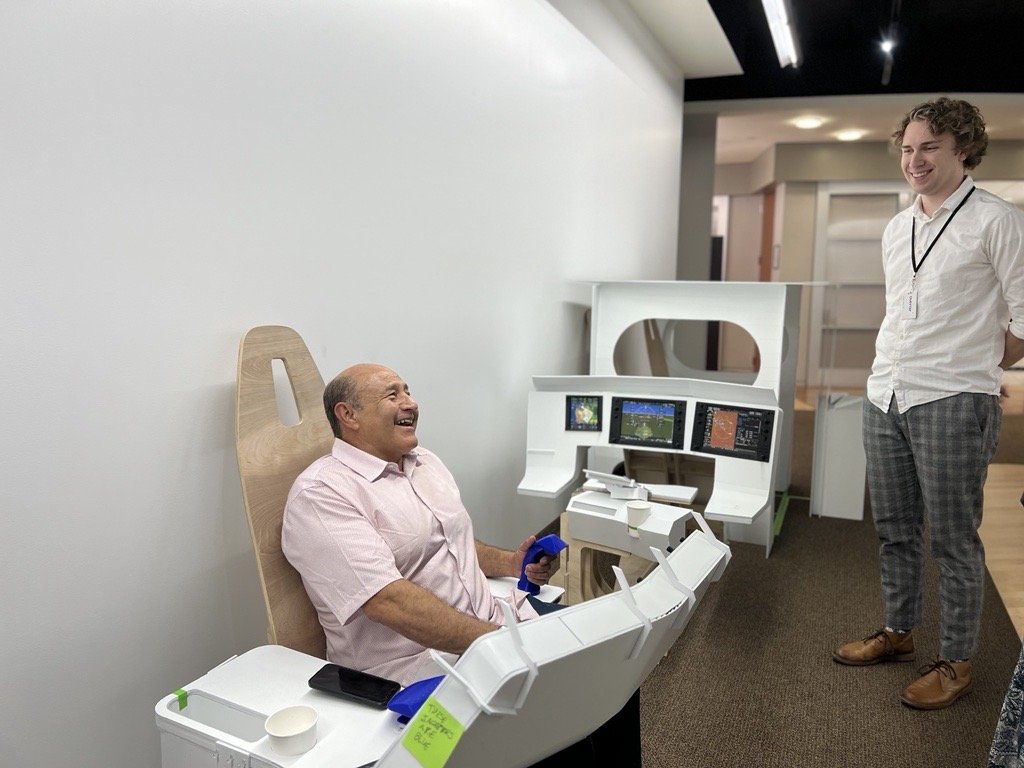Overair Internship
Flight deck design
My internship at Overair took place over the course of about 3 months. I primarily worked on a team with 2 other designers working closely with engineers and test pilots on the development of their Butterfly eVTOL (electric vertical take-off and landing) aircraft. My assignment was to begin the design of the flight deck so that at the end of the internship period, they would have a solid starting point as development continues.
Disclaimer: This project was for the purpose of exploring a range of flight deck concepts and layouts, not creating a complete/rounded-out design. None of the designs shown are final or represent the official design direction of Overair Inc.
*This is not my render/design, this is a public image of the Overair Butterfly aircraft
Prototyping
Quickly making and testing physical prototypes was a significant portion of the internship. I made 10 prototypes of varying fidelity to test out different control schemes and refine the ergonomics of the cockpit design.
Low-Fidelity Round 1
The first round of prototypes had swappable panels, that could be adjusted by height, position, and angle to determine the approximate layout of the flight deck
Low-Fidelity Round 2
The second round of prototypes loosely mocked up various instrumentation configurations and explored
Medium-Fidelity
The third round of prototypes was a pair of contrasting higher-fidelity prototypes (one side-justified, one centered).
CONCEPT A
CONCEPT B

Design Testing
Over the course of the project, prototypes (especially the higher fidelity ones) proved to be very useful at sparking conversation and communicating the balances that our design would have to strike for other disciplines. It helped to moderate more extreme opinions of how the flight deck should be designed (e.g., with very little or much more instrumentation). Ultimately, it made discussions of the design process much more democratic and accessible.
Pictured is Rep. Lou Correa (D-CA 46th District) trying out one of the flight deck prototypes. Congressman Correa came to Overair to learn more about their work as he works on legislation related to operating eVTOL aircraft.
Design Feedback
The fidelity of the prototypes varied according to the specificity of feedback needed. The prototype shown to the right is marked up with sticky notes of the feedback from two test users.
On some occasions, after giving blind feedback, test users would be shown the feedback others had given to get their thoughts.
Design Concept
Armrest flips up for easy entry and exit
The armrest hinges and flips up so pilots can easily enter/exit the vehicle while maintaining the comfort and ease of use of a larger flight deck that’s used for longer durations. It also maintains visibility through the lower glazing.
Design can be mirrored as needed
A factor that adds uncertainty is the state of eVTOL regulation and the development of common conventions for this new class of vehicle that lacks a standard configuration. The design shown can be mirrored for a right-justified pilot depending on the helicopter influence on future eVTOLs’ flight decks.
Flight modes shown with indicator lights
Flight modes are shown with indicator lights to prevent negative transfer when changing between vertical, transition, and forward flight mode
Balance of visibility and instrumentation
The flight deck needed to balance the needs of vertical (rotorcraft) flight (significant line of sight visibility) and forward (fixed-wing) flight (instrumentation for flight planning). The design concept balances these needs while following FAA guidance (AC 27.773).













